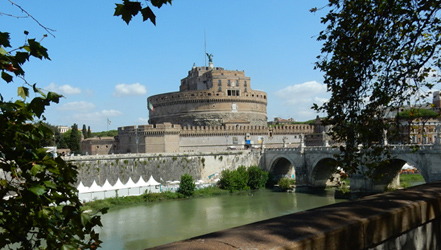Michelangelo Merisi spent several years of his short life in Rome, where the wealthy aristocratic and cardinal families of the Vatican commissioned him many of his most important works. 26 out of 78 works by Caravaggio find their place in the capital.
Three of these belong to private collections and therefore it is not possible to admire them.
Caravaggio was a controversial artist with an irascible character. He lived a dissolute life, often involved in fights. He used to frequent prostitutes who he also used as models for his paintings. During a fight Caravaggio committed a murder. This is how he was sentenced to death. This sentence forced him to live like a fugitive for the rest of his life. He died that he was not even 40 under unclear circumstances. His body was found lifeless on a Tuscan beach probably while he was trying to escape capital punishment.
After his death, posterity because of his questionable conduct tried to denigrate his art. Over the centuries, however, Caravaggio has been consecrated as one of the great masters of Italian art and a great pictorial innovator. The naturalism of the subjects represented emerges dramatically thanks to an almost theatrical use of the violent light that shapes the figures. The strong contrasts between light and shadow, with figures illuminated by beams of light suddenly emerging from the dark characterizes most of his works. Sometimes old and deformed characters in the role of revered saints and the faces of prostitutes and humble women who embody madonnas or noblewomen give his masterpieces a raw realism. We can often find strongly characterized characters in Caravaggio's painting, with contracted and extremely expressive faces.
Caravaggio's works in Rome: Borghese Gallery
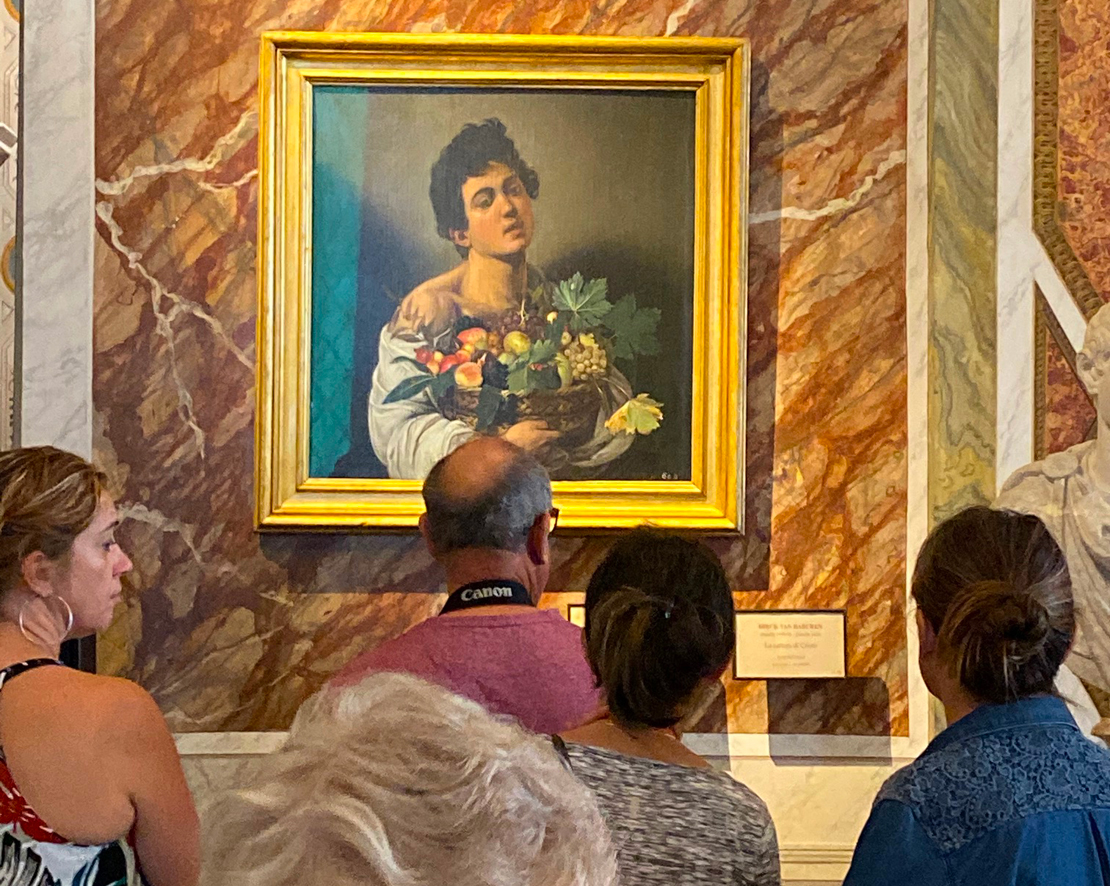
Galleria Borghese in Rome is one of the richest museums of Caravaggio's masterpieces. There are 6 paintings by Caravaggio exhibited in the museum of Villa Borghese: the Bacchino Malato, San Girolamo Scrivente, San Giovanni Battista, David with the head of Goliath, the Madonna with the child and Sant'Anna, the boy with a basket of fruit.
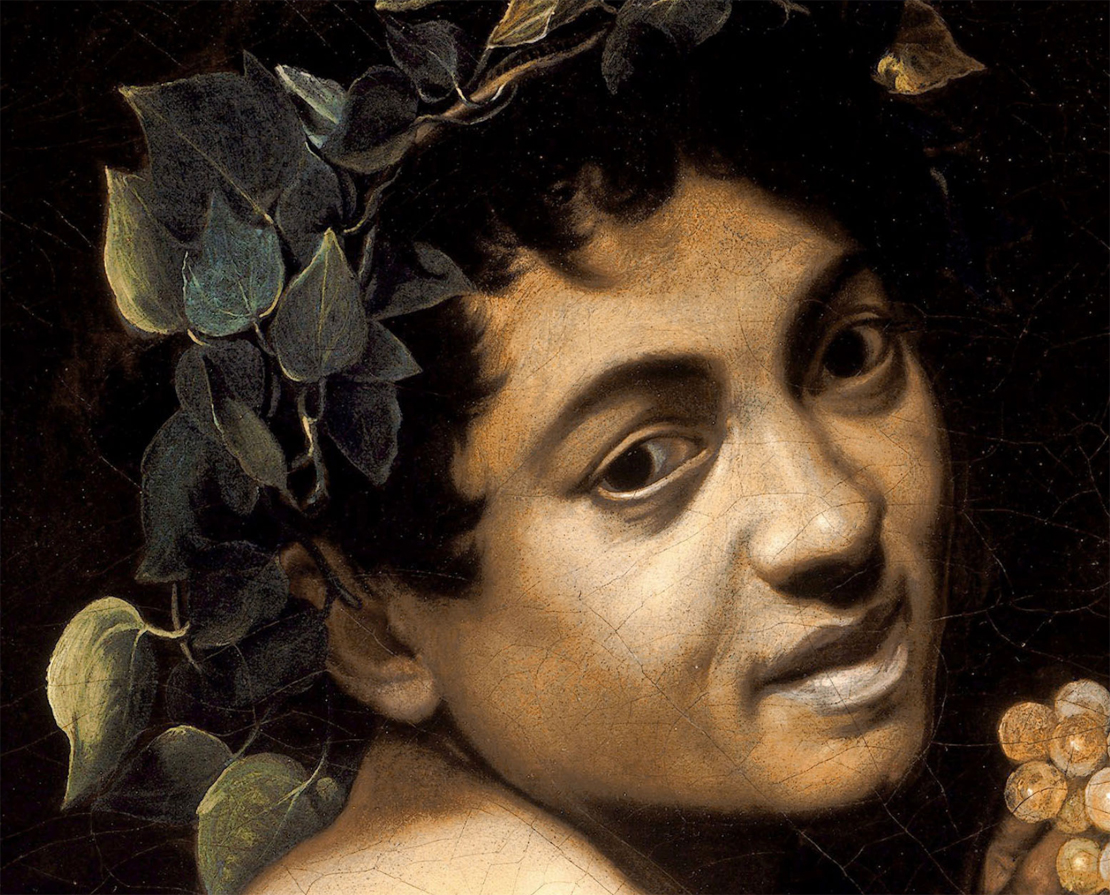
The Sick Bacchino was painted between 1593 and 1594. It is an oil on canvas depicting a young man, perhaps a self-portrait, where the artist emphasizes the emaciated air of the young man, with a pale complexion and bluish lips, a marked and imperfect body. The crown of leaves on his head as well as the fruit is represented in a very naturalistic way. It almost seems to be able to touch the grapes, some of which are surprisingly rotten.
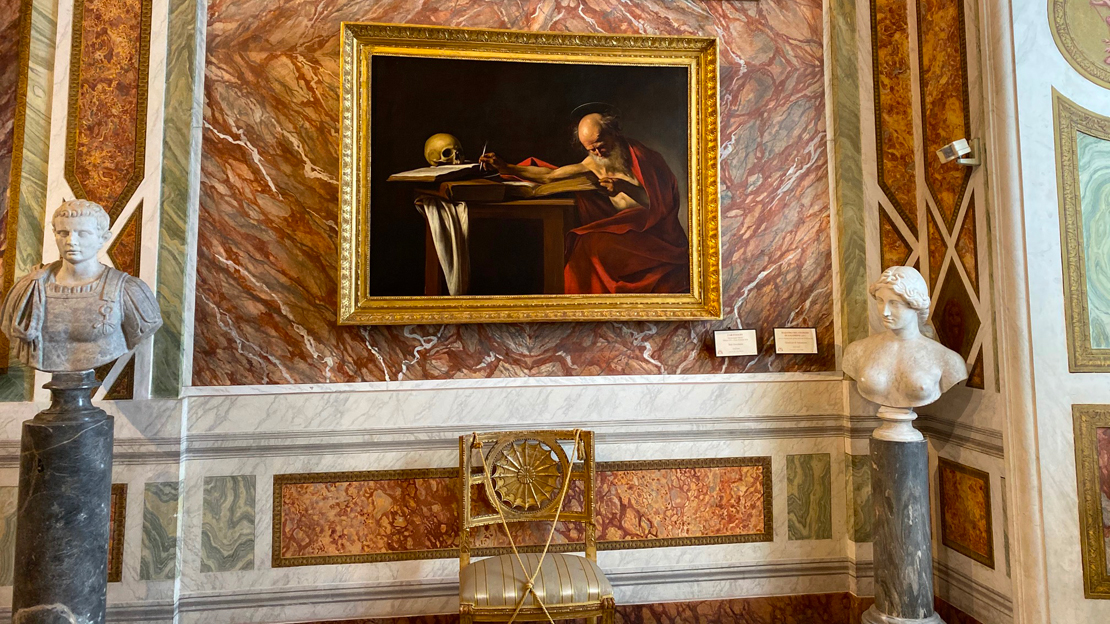
The San Girolamo Scrivente is also an oil on canvas from 1605-1606. San Girolamo is depicted in ¾ and part of the painting is occupied by the desk and the objects that are on the table. San Girolamo seems to be part of this still life set. Few colors between brown and burnished, the painting appears sober and gaunt even in the scarcity of elements represented, the only strong note of color is the red of the saint's mantle.
San Giovanni Battista is an oil on canvas made in 1610. A subject that Caravaggio also paints in other canvases.
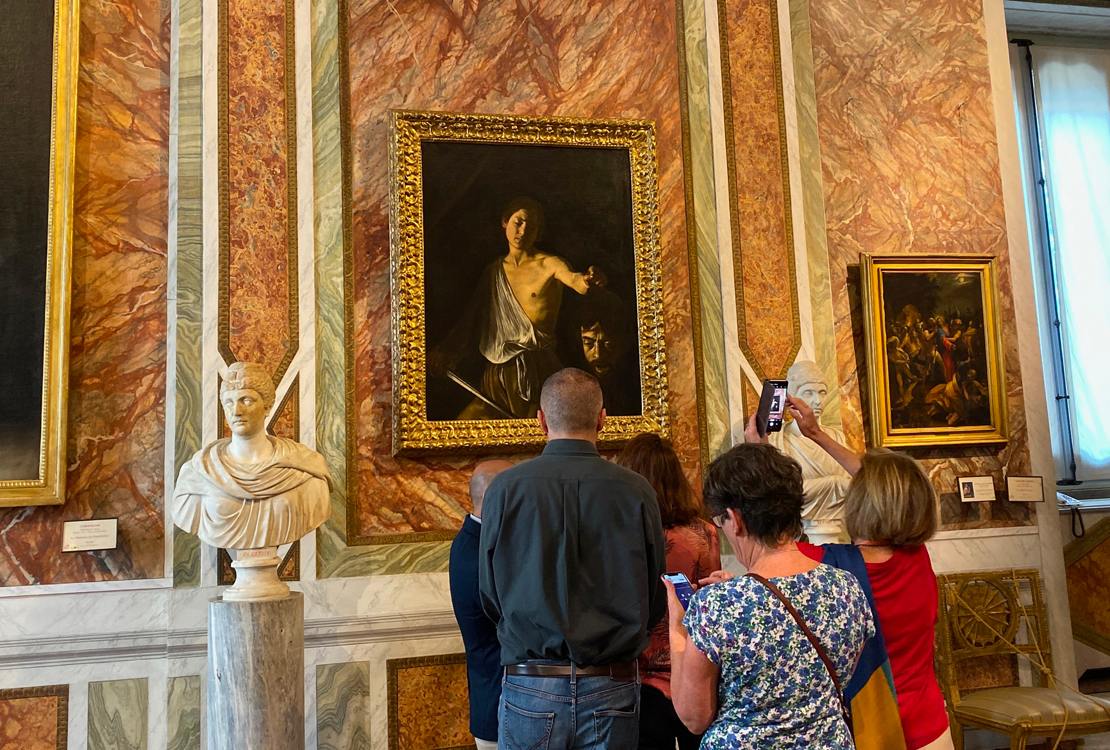
David with the Head of Goliath is an oil on canvas painted perhaps in 1609. In this painting there is a strong contrast between the darkness that literally engulfs David's shoulder and the rest of his body illuminated by a beam of light. David looks with compassionate expression on the head of Goliath , this last with an expression instead distorted and also almost swallowed up by the infernal darkness.
The Madonna and Child with Saint Anne is a large oil on canvas always exhibited at the Borghese Gallery in Rome painted in 1605. A painting that made much discussion. An unprecedented image of the Child Jesus involved in the killing of the snake that suddenly crawls at his feet. Also in this painting, light plays a fundamental role in shaping the volumes of clothes and figures.
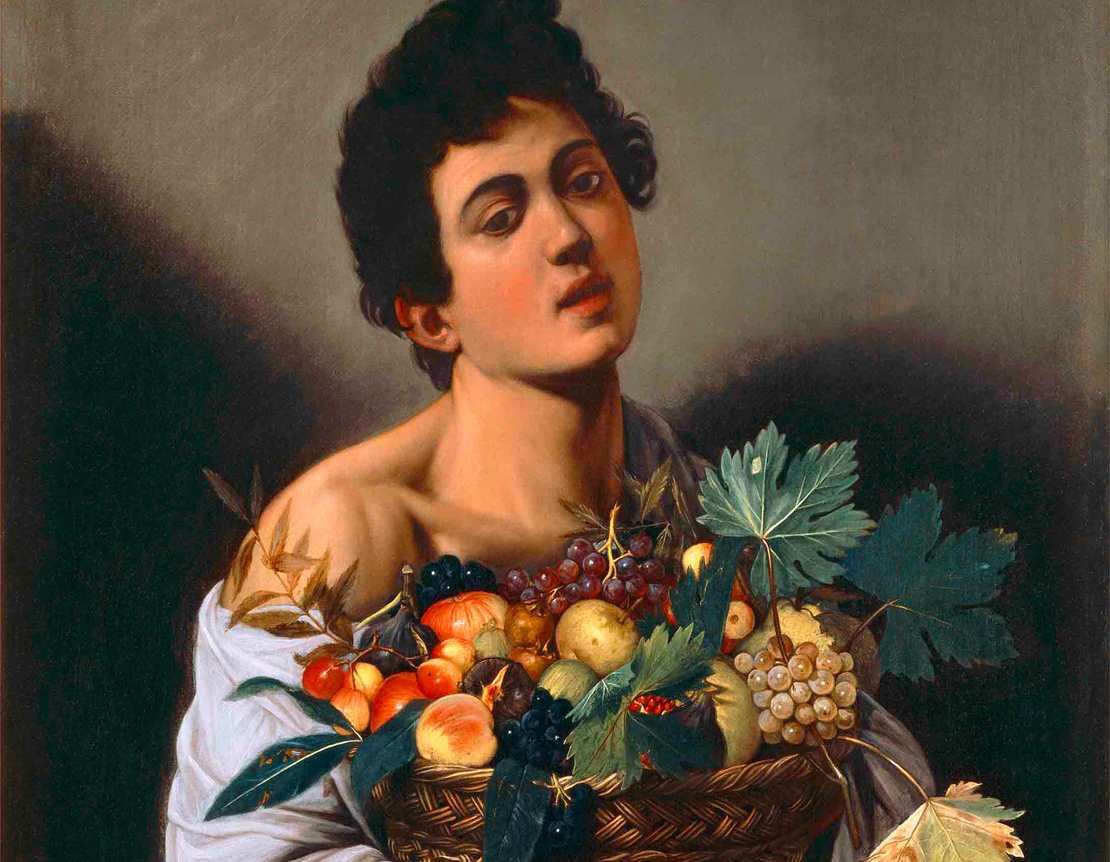
The Boy with the Fruit Basket is one of Caravaggio's most famous paintings, also exhibited in the museum of Villa Borghese in Rome. A rather small oil on canvas dating back to the time when Caravaggio resided in Rome, presumably between 1593 and 1594. The boy, whose face does not have a known identity, is dressed in a simple hanging white shirt that leaves the shoulder and most of the neck uncovered. He is sensually holding up a basket overflowing with fruits: apples, bunches of grapes shining and still damp with frost, and leaves. It is believed that the work is the result of an artist's reflection on the inexorability of the passage of time, an allusion to the transience of life and the ephemeral nature of worldly goods.
To visit Galleria Borghese it is necessary to make a reservation in advance because the museum is accessible only to a limited number of visitors. The best way to get to know and appreciate the works of Caravaggio in this museum is to book the tour with a private guide of the Borghese Gallery. Two hours and thirty in the company of an expert guide of the subject to listen to the life and commentary of these magnificent 6 works.
Book Tickets for Borghese Gallery
Caravaggio's works in Rome: the Capitoline Picture Gallery
The Pinacoteca Capitolina is part of the Capitoline Museums, located in Piazza del Campidoglio in Rome. The famous museum houses a huge amount of ancient finds, but also a remarkable collection of paintings, among which two Caravaggio's masterpieces stand out. Here are the two works by Michelangelo Merisi that can be admired at the Capitoline Museums: San Giovanni Battista and Buona Ventura.
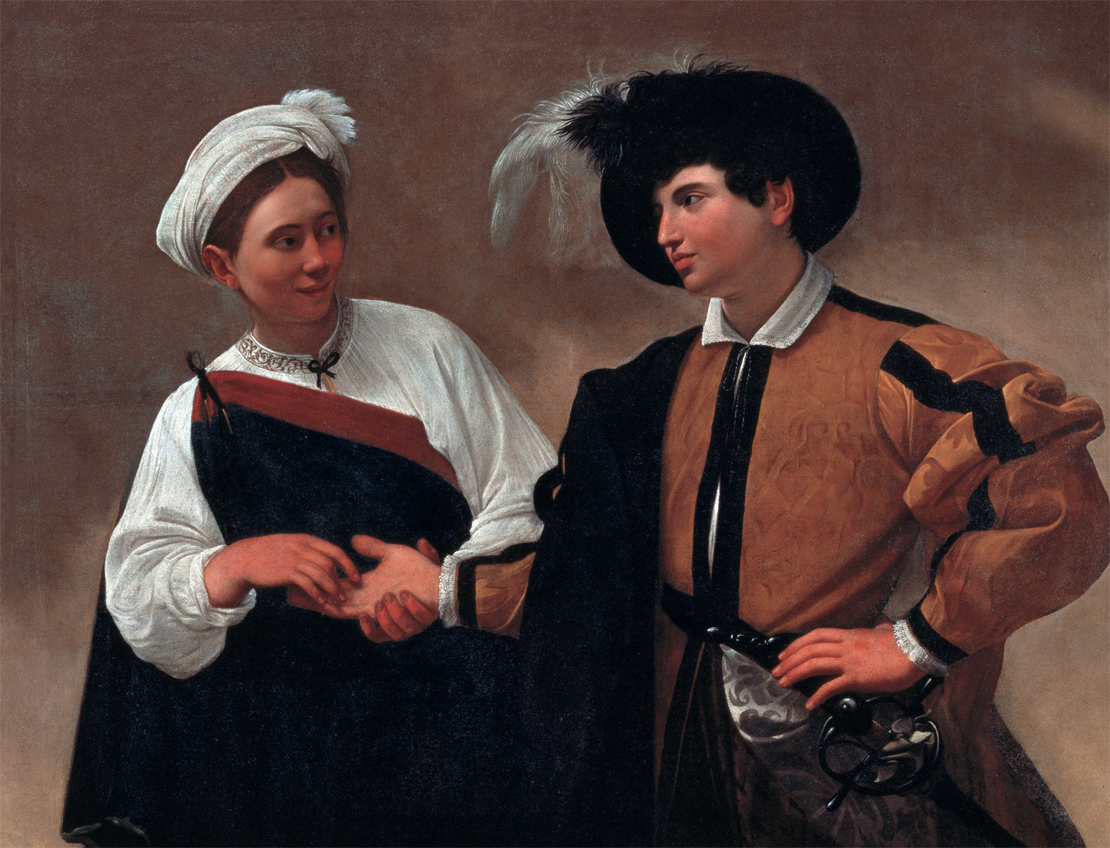
In Buona Ventura a gypsy is portrayed reading a knight's hand. While doing this she steals the ring he wears on her finger. A pretty gypsy, and a naive young man from a good family victim of the gypsy's malice, who catches the young man's attention with his mischievous look, skillfully pulling a ring from his finger. The boy's plump face reflects his disarming naivety, a real psychological subtlety that emerges from the expressions of the two characters.
Book tickets for the Capitoline Museums
Caravaggio's works in Rome: the National Gallery of Ancient Art
Here the works on display by Caravaggio are 3: Narciso, Giuditta and Oloferne and San Francesco in prayer.
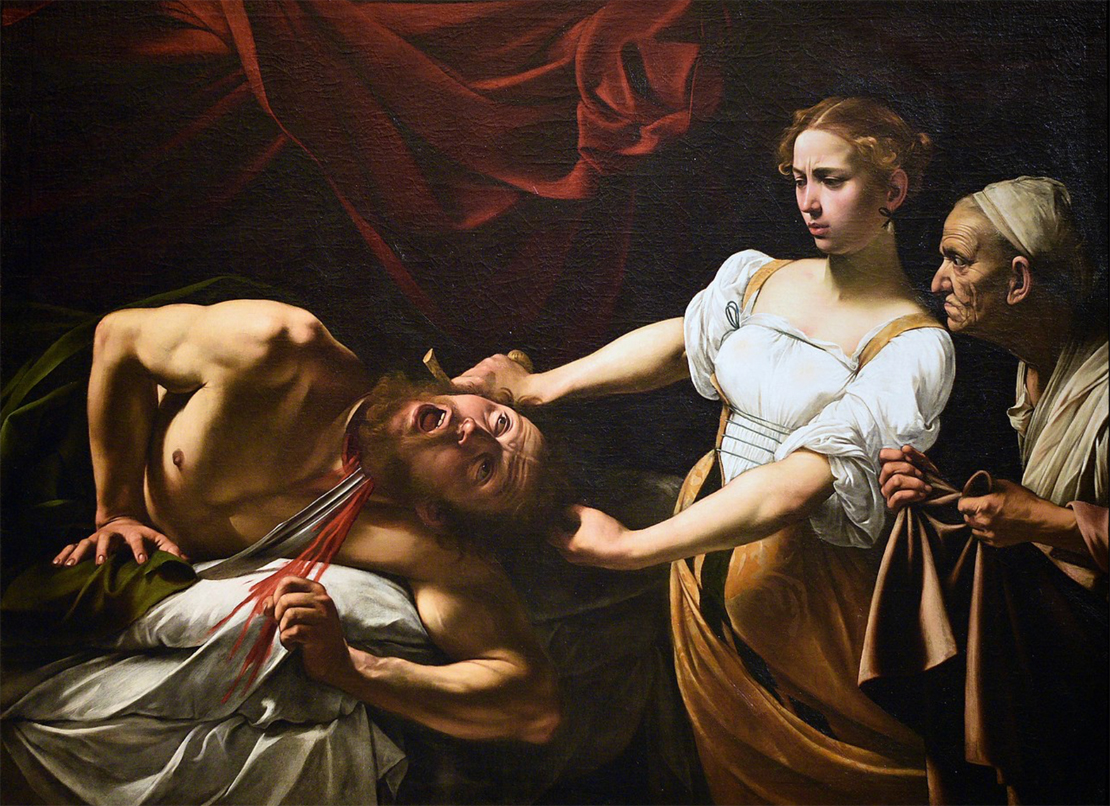
Giuditta and Holofernes is an oil on canvas that Caravaggio made in 1597. In this picture is represented the biblical episode of the beheading of the Assyrian leader Holofernes by Judith, who wanted to save her people from foreign domination. Giuditta beheads Holofernes with a scimitar, an old servant attends the scene holding the cloth containing the basket in which the head will be kept.
Narciso is an oil on canvas attributed to Caravaggio although the attribution of this work is still a matter of debate. The painting depicts a vertical scene, Narcissus is depicted in the act of mirroring himself; its image is reflected in the water of a source. Caravaggio tries to capture the moment just before the boy will discover the deception, the image of the pool is nothing but the projection of himself.
Caravaggio's latest work at the National Gallery of Ancient Art is San Francesco in meditation, a painting in shades of brown that depicts the saint while he is talking to a skull, perhaps inside a cave, in the scene besides man, there is a cut trunk supporting a skinny cross.
Book your ticket to visit the National Gallery of Ancient Art at Palazzo Barberini in Rome!
Caravaggio's works in Rome: the Vatican Pinacoteca
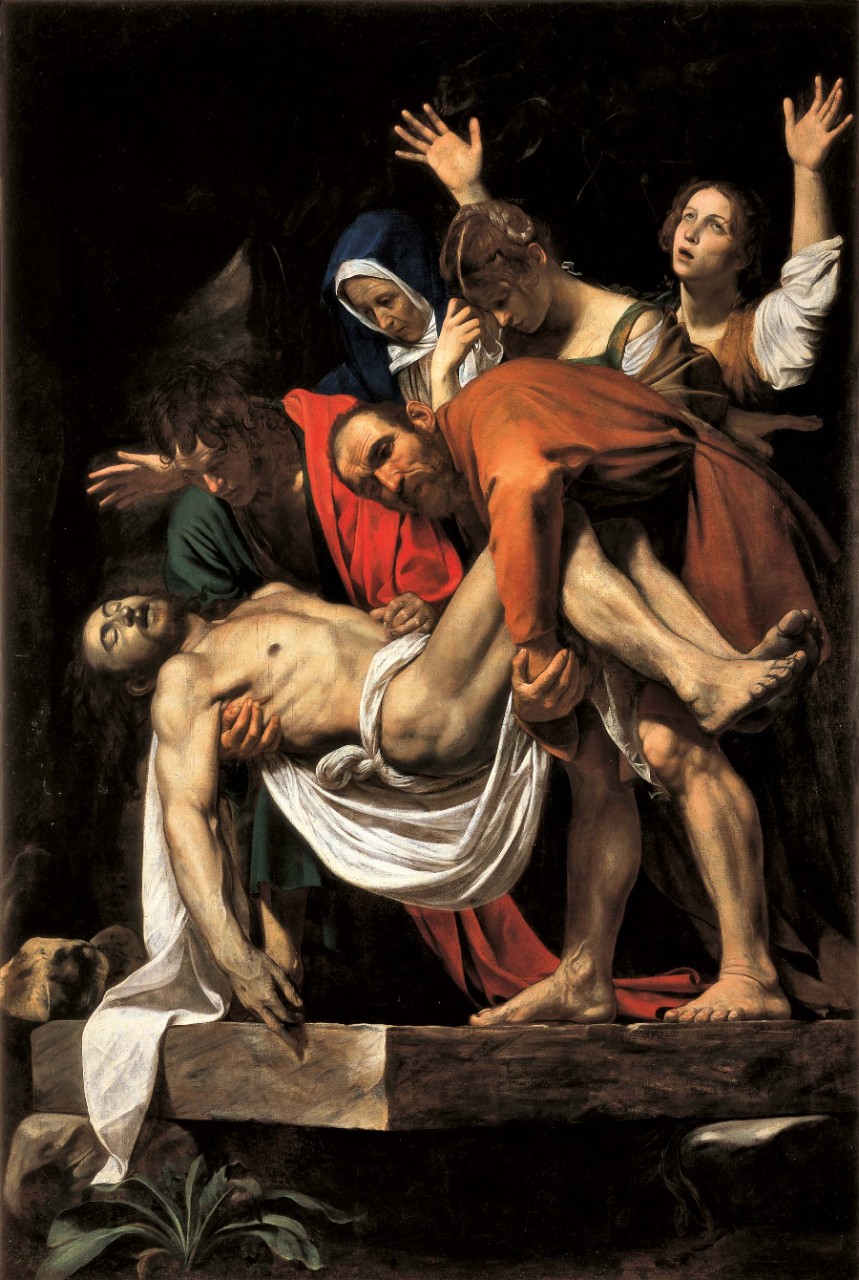
In the Vatican Museums and more particularly in the Vatican Pinacoteca there is a single large painting by Caravaggio, the Deposition of Christ.
The only painting by Caravaggio in the Vatican Museums is the Deposition of Christ, a large oil painting created between 1602 and 1604 now preserved in the Vatican Pinacoteca, which can be visited by purchasing a ticket for the Vatican Museums of which the pinacoteca is an integral part.
The grandiose and impressive work portrays the moment when Jesus is about to be buried in the underground tomb. The observer's point of view is below, since it is a painting intended to decorate an altarpiece. The monumental aspect of the composition is recalled by the dramatic and sculptural anatomy of the body of Christ that reminds us of Michelangelo's Pietà. A dramatic moment accentuated by the corner of the stone of the tomb, an unusual frontal cut to the eye of the observer. The lifeless body of Jesus seems to fall dramatically downwards, laboriously supported by the apostles John and Nicodemus. The action of the body tof Christ hat sinks towards the bottom is opposed to the energetic gestures of the other characters. Nicodemus is the only one who looks towards the observer. A curiosity, the features of the apostle's face are nothing more than the portrait of Michelangelo Buonarroti of which Caravaggio certainly had great admiration. The subjects of the painting are portrayed with a wealth of details typical of Caravaggio's naturalism: such as wrinkles on the faces, the folds of the clothes, the knot of the sheet, the braids of one of the women, the veins and wounds of the body of Christ, the his ribs and muscles.
Book tickets for the Vatican Pinacoteca
Caravaggio's works in Rome: the Doria Panphilj Gallery
The works of Caravaggio kept here are 3.
San Giovanni Battista, very similar to the subject we find at the Capitoline Picture Gallery. The painting was compared precisely with that exhibited at the Capitoline Museums. Recently it seems to have been revealed that it is a copy very well executed but not attributable to Caravaggio.
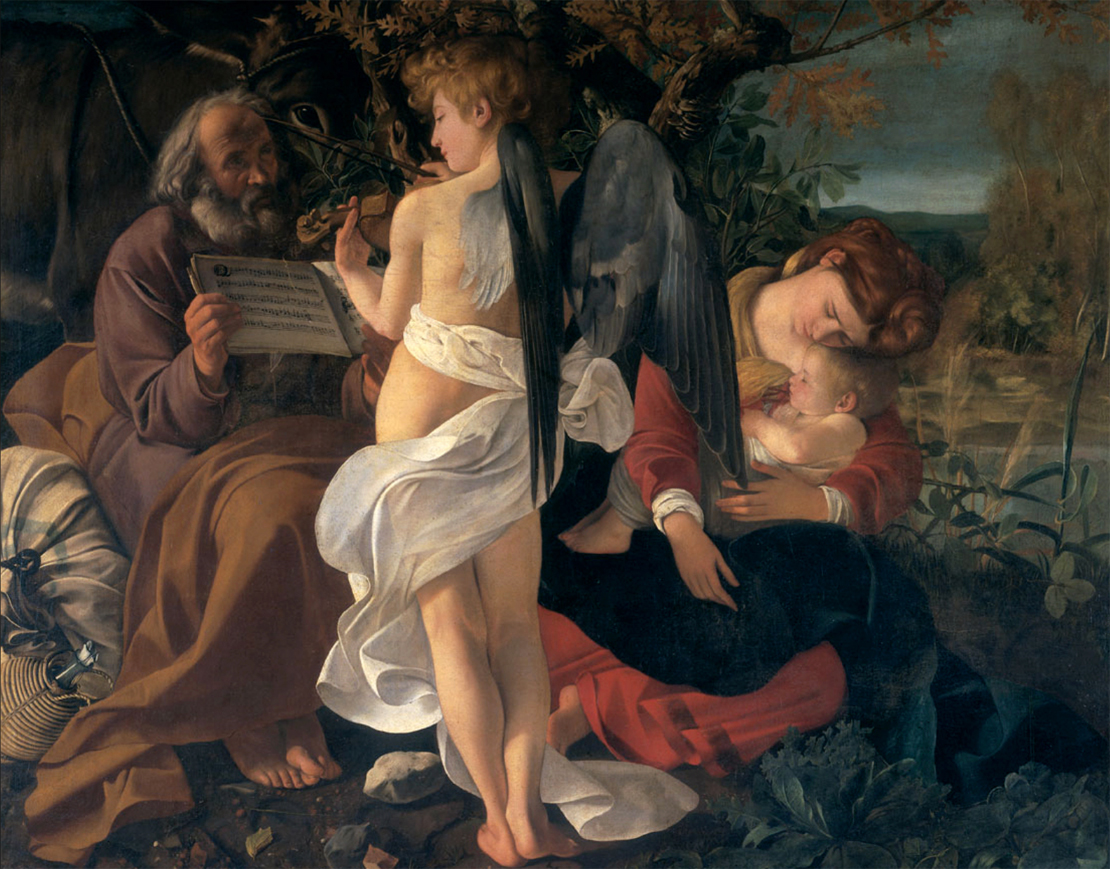
The other two paintings are certainly certainly by Merisi.
Rest on the Flight to Egypt is a magnificent painting from 1597 by a young Caravaggio. Caravggio paints an idealized scene with a luxuriant nature, an unusually beautiful angel with shoulders, an idealized beauty also in the faces of the characters and in the bright colors with golden hues. The only subject that stands out from the idyllic theme of the composition is Giuseppe with a face that feels tired from the long journey.
The Penitent Magdalene is also a painting from 1597 and depicts Magdalene who has just denied her past life as a sinner. The surrounding environment is very meager and contrasts with the rich clothes of a worldly life whose traces are found in the string of pearls abandoned on the ground together with a jar of ointment. Here too, the colors are typical of the early artistic period of Caravaggio, light, golden and bright. However, the light already appears to be the protagonist with the oblique beam of light that pierces the darkness of the background. A prelude therefore to his more mature art, characterized by the violent contrast between darkness and dazzling light that shapes human figures and still lifes.
Caravaggio's works in Rome: Villa Ludovisi
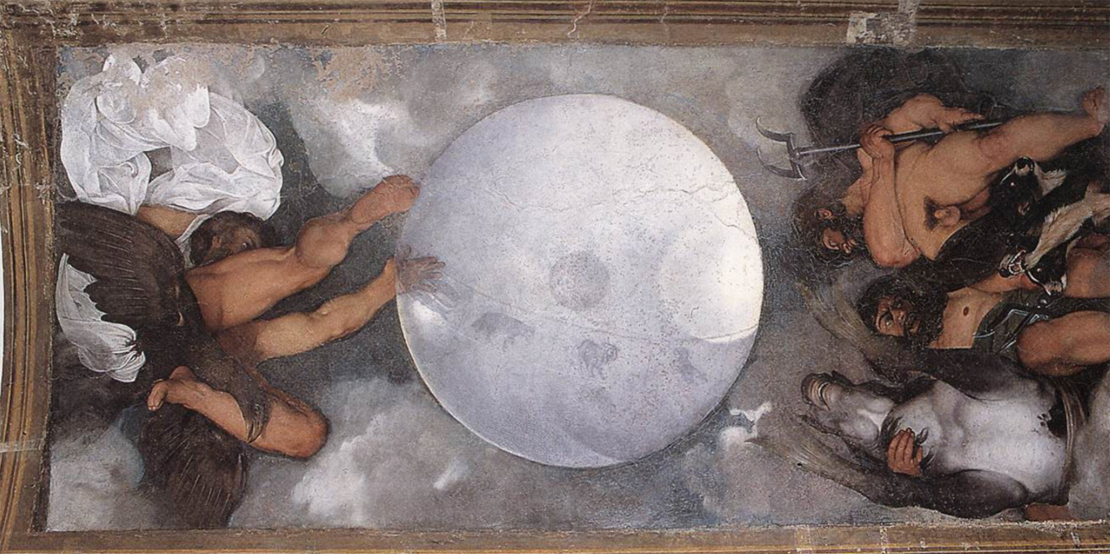
Jupiter, Neptune and Pluto.
Another work from Caravaggio's youthful period, perhaps dated around 1597. This is the only fresco by the master.
This wall painting represents the three divinities associated with three elements: Jupiter (Air), Pluto (Earth), Neptune (Water) which make up the three alchemical layers of matter (gaseous-solid-liquid). The three deities are also associated with three symbolic animals Jupiter with the eagle, Pluto with Cerberus triumphal guardian of the underworld in the underground cavities and Neptune with the gray-finned sea horse.
Caravaggio's works in Rome: Palazzo Corsini Gallery
A subject dear to Caravaggio, here San Giovanni Battista is portrayed as a young man with a shady expression and ruffled and rebellious hair.
Caravaggio's works in Rome: church of San Luigi dei Francesi
Triptych of the Conversion of San Matteo. This splendid triptych is preserved and exhibited in the Contarelli Chapel of the church of San Luigi dei Francesi in Rome. It is a real pictorial cycle, which starts with the Vocation, the Martyrdom and the Inspiration of San Matteo.
This work was carried out between 1599 and 1602 on commission from Cardinal del Monte. These are three oils on canvas of large dimensions and of great scenographic effect.
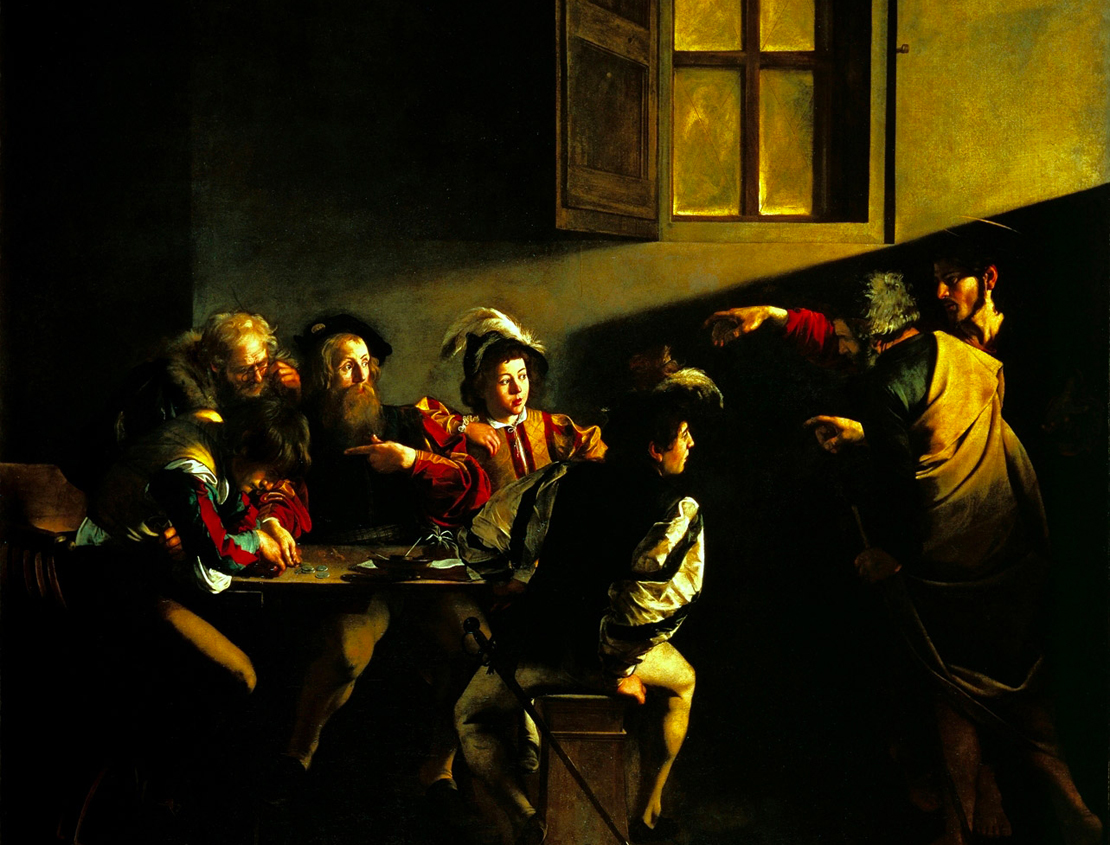
In the Vocation of St. Matthew we see the moment when Christ calls the apostle indicating him. San Matteo sits at a table with a group of people, dressed like Caravaggio's contemporaries, a scene that recalls the atmosphere of a tavern. The beam of light that cuts the scene accentuates the drama of the event.
We find a great contrast of chiaroscuro in the representation of Saint Matthew and the Angel. A deep darkness in the background is torn open by a beam of light that illuminates St. Matthew and the angel who appears from above. In the scene of the Martyrdom of St. Matthew, also a very large picture, the scene develops concentrically around the figure of an executioner in the act of striking the future martyr.
Caravaggio's works in Rome: church of Santa Maria del Popolo
Crucifixion of Saint Peter and the Conversion of Saint Paul. In the Cerasi chapel of the church of Santa Maria del Popolo in Rome we find another famous masterpiece by Caravaggio, the Crucifixion of St. Peter, a dynamic and realistic composition, a large oil on canvas made around 1600. A spectacular work by Caravaggio characterized by a lighting that breaks through, tearing the darkness to illuminate the characters of the scene defined in detail: the grain of the wood of the cross, the black foot of the torturer bent towards the ground, the wrinkles on the forehead of the torturer placed on the left, the reflection of the light on the nails of the Saint and the tormentor who tends the rope.
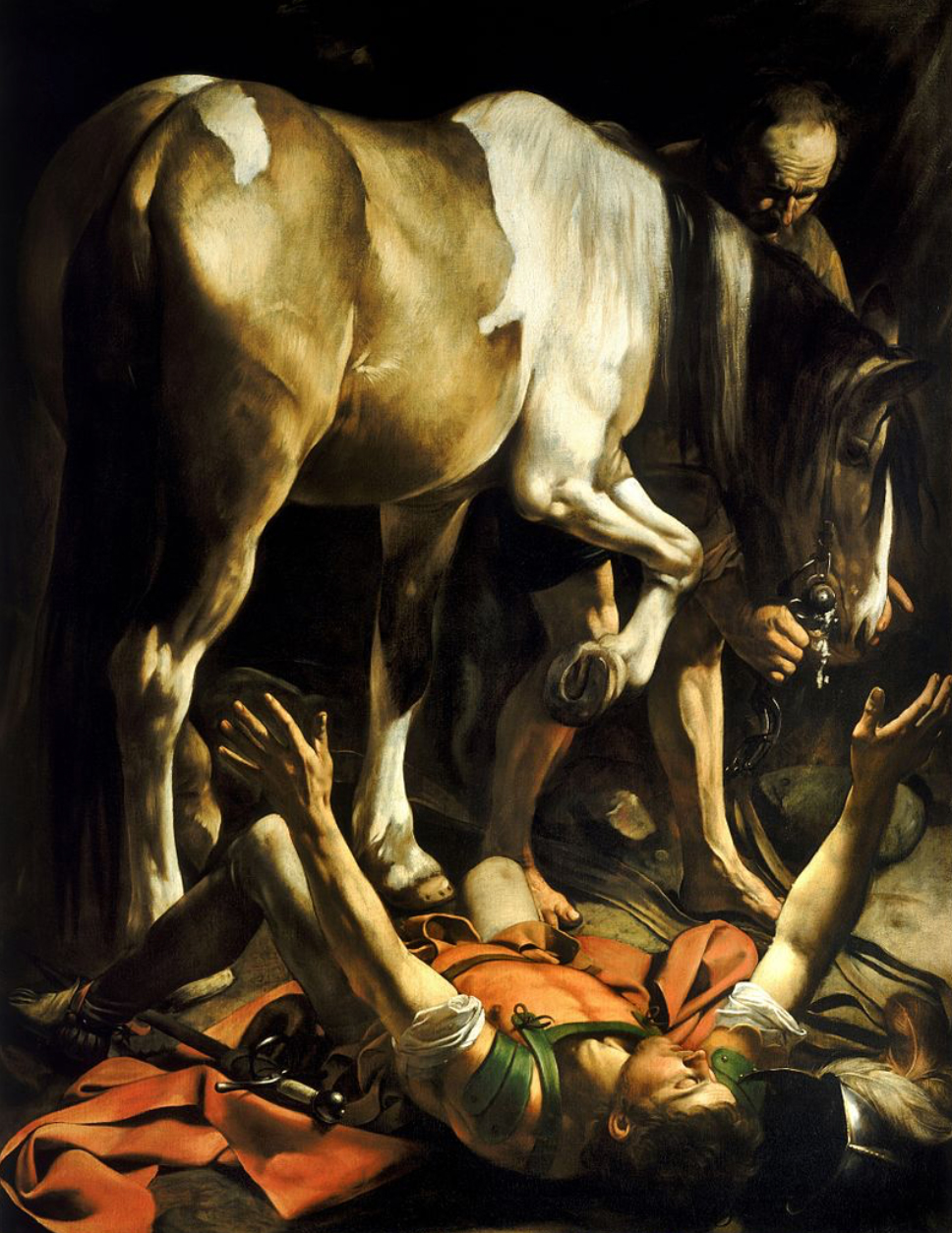
Also in the same Cerasi chapel it is also possible to admire the Conversion of St. Paul, another famous work by Caravaggio. The large oil painting depicts the moment when Saint Paul is literally blinded by the divine light on the road to Damascus. He falls to the ground, while the old horse raises his paw so as not to step on the man with the hoof.
Caravaggio's works in Rome: Basilica of Sant'Agostino
Finally the beautiful Madonna of the pilgrims preserved in the Cavalletti Chapel in the Basilica of Sant'Agostino in Rome. A large oil on canvas depicting the Madonna with the arm of the child Jesus not on the throne as the artist's contemporaries were usually accustomed to seeing in the iconography of the time, but leaning against the jamb of a church.
These last three churches that exhibit 6 large paintings by Caravaggio are the three stages of a tour "Caravaggio in Rome" that can be carried out all year round in the company of an expert on the subject to discover these 6 of the most important masterpieces of the great master.



 EN
EN  ES
ES  DE
DE  FR
FR  IT
IT 
